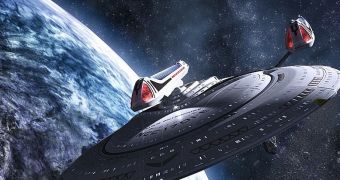The following article is an excerpt from work by David Allen Batchelor, available online here.
Generally, Star Trek is pretty intelligently written and more faithful to science than any other science fiction series ever shown on television. Star Trek also attracts and excites generations of viewers about advanced science and engineering, and it's almost the only show that depicts scientists and engineers positively, as role models. So should we forgive the show for an occasional misconception in the service of an epic adventure?
Well, as for the science in Star Trek, Gene Roddenberry and the writers of the show have started with science we know and stretched it to fit a framework of amazing inventions that support action-filled and entertaining stories.
The writers of the show are not scientists, so sometimes they do get science details wrong:
Holding your breath in space
There was a show in which Dr. Crusher and Mr. LaForge were forced to let all of the air escape from the part of the ship they were in, so that a fire would be extinguished. The doctor recommended holding one's breath to maintain consciousness as long as possible in the vacuum, until the air was restored. But as underwater scuba divers know, the lungs would rupture and very likely kill anyone who held his breath during such a large decompression. The lungs can't take that much pressure, so people can only survive in a vacuum if they DON'T try to hold their breath.
Warp Interstellar Drive
This must be the crowning achievement of Federation technology! Despite its fundamental role in the show's plot, it violates known physics to an extent that can't be defended. The detailed explanation of the warp field effect in the ST: TNG Technical Manual only raises more questions than it resolves. It is said to involve huge discharges of energy and subspace fields that aren't understood in today's science. However, barring a very unlikely demolition of Einstein's theory by future, revolutionary discoveries in quantum physics, warp drive can't exist. Physicists of today understand the space-time continuum rather well, and there is very good reason to think that no object can move faster than the speed of light. This doesn't stop scientists like the great expert on relativity and quantum theory, Stephen Hawking, from enjoying the fun of the TV series, however.
Matter-Antimatter Power Generation
This is one of the best scientific features of Star Trek. The mixing of matter and antimatter is almost certainly the most efficient kind of power source that a starship could use, and the way it's described is reasonably correct -- the antimatter (frozen anti-hydrogen) is handled with magnetic fields, and never allowed to touch normal matter, or KA-BOOM! This much is real physics. Let's not bother about the dilithium crystals part... sorry, but that's just imaginary.
Androids
Well, an important research organization for robotics is the American Association for Artificial Intelligence. At a recent conference on cybernetics, the president of the Association was asked what is the ultimate goal of his field of technology. He replied, "Lieutenant Commander Data." Creating Star Trek's Mr. Data would be a historic feat of cybernetics, and right now it's very controversial in computer science whether it can be done. Maybe a self-aware computer can be put into a human-sized body and convinced to live sociably with us and our limitations. That's a long way ahead of our computer technology, but maybe not impossible.
Transporter
We don't have a clue about how to really build a device like the transporter. It uses a beam that is radiated from point A to point B where it STOPS at just the right precise place - even passing through some barriers along the way - and reconstructs the person it carries on the spot. Or it captures a person's pattern, dematerializing him or her, and brings the person to some other point. All of the rematerialized atoms and molecules are somehow in the precisely correct positions, with the right temperatures and adhering together just as if the transportee had not been dematerialized. Rematerializing, why doesn't everything fall to pieces if a gust of wind or just normal gravity disturb the reappearing atoms?
Holodeck
The same applies to this one. Holograms are apparent images with three dimensional structure. Although virtual reality rooms have been created, we can't imagine a way to assemble matter in the same way as the light in a hologram.
Universal Language Translator
As this is used on the Star Trek shows, it's just a fictional device to enable characters to get through the stories. It would be too tedious and repetitious in a one-hour show for the characters to overcome real language barriers in a realistic manner in every show. The way the Enterprise crew can encounter an alien spacecraft, "hail them on standard frequencies," and establish instant telecommunications on their viewscreens is a preposterous shortcut to keep the plot from faltering. We can certainly dismiss the possibility of such an invention ever being built.
So, the bottom line is: Star Trek science is an entertaining combination of real science, imaginary science gathered from lots of earlier stories, and stuff the writers made up week-by-week to give each new episode novelty. The real science is an effort to be faithful to humanity's greatest achievements, and the fanciful science is the playing field for a game that expands the mind as it entertains. The Star Trek series are the only science fiction series crafted with such respect for real science and intelligent writing. That's why it's the only science fiction series that many scientists watch regularly...

 14 DAY TRIAL //
14 DAY TRIAL //